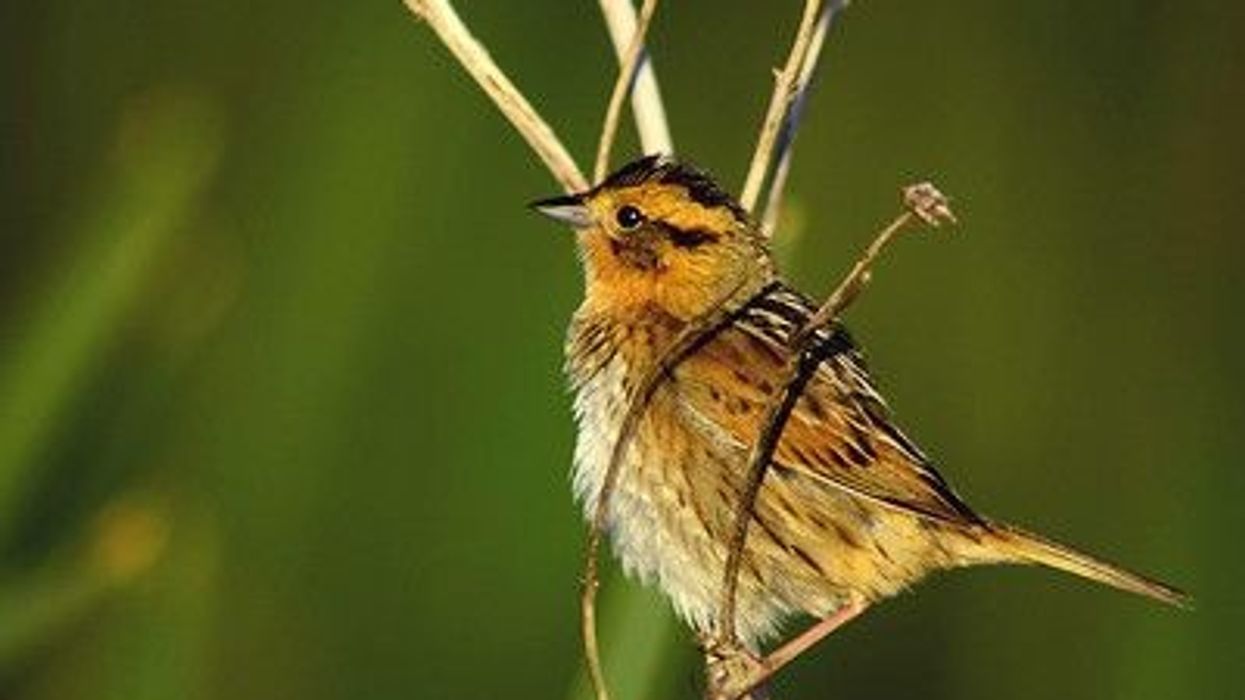The stitchbird, or Hihi (Notiomystis cincta), is a songbird that is endemic to the North Island and offshore islands around New Zealand. Most of the population of this species can be found in the Great Barrier Island, Little Barrier Island (Hauturu), and Kapiti Islands.
Hihi birds have been translocated with more success to Kapiti Island, Tiritiri Matangi Island, Karori Sanctuary, Maungatautari, Bushy Park, and Rotokare as of 2018.
It was initially classified as a part of the Meliphagidae honeyeater family found in New Guinea and Australia. It remained characterized as such until genetic analysis revealed that the stitchbird is not strongly related to honeyeaters and their allies and that its common heritage is members of the Callaeidae family endemic to New Zealand.
In order to contain the stitchbird (Hihi), a new Passerine family, known as Notiomystidae, was created in 2007.
They had almost become endangered as their population started to decline in 1885. The reason was unknown but it was speculated that deterioration in habitat, as well as the introduction of black rats in the forests, led to the near-extinction of the Hihi.
Soon New Zealand's government set up different projects to rehabilitate the birds and presently they have shifted to being a Vulnerable species, but the projects are still working to increase the population.
Scroll down to read about the stitchbird's life span, what they feed on, their habitat, and other exciting details! If you want to discover more animals like the stitchbird (Hihi), take a look at moorhen facts and grouse facts.
Stitchbird Interesting Facts
What type of animal is a stitchbird?
The stitchbird (Notiomystis cincta) is a rare bird often mistaken for honeyeaters, endemic to the North Island and adjacent offshore islands of New Zealand.
What class of animal does a stitchbird belong to?
The stitchbird or Hihi (Notiomystis cincta) belongs to the class Aves and the Passeriformes order.
How many stitchbirds are there in the world?
Even though there isn't an exact assessment of the populations of stitchbirds (Hihi) in the world at present, it is believed that there are only 150 adult birds as of now on Tirtiri Island while there are 600-6000 adult birds on Little Barrier Island.
The stitchbird is a Vulnerable species and the government of New Zealand has intervened for years, relocating the birds and trying to help them breed in order to increase their number so that they don't almost go extinct again.
Where does a stitchbird live?
The Hihi tends to forage in areas where there are dense and mature native forests filled with various flowers and wild fruits.
What is a stitchbird's habitat?
Stitchbirds can be found in forest areas of the North Island as well as the Great Barrier Island, Little Barrier Island (Hauturu), and Kapiti Islands. The Hihi species are endemic to New Zealand and can be found mostly in offshore island sites.
After the decline in the population of the stitchbirds, the government tried to rehabilitate the birds in different areas- Hen Island, Cuvier Island, Mokoia Island, Waitakere island but it was unsuccessful. Stitchbirds have been translocated for conservation with more success to sites like Kapiti Island, Tiritiri Matangi Island, Karori Sanctuary, Maungatautari, Bushy Park, and Rotokare as of 2018.
Who do stitchbirds live with?
Stitchbirds are neither solitary animals nor do they stay together in groups. Rather these species in polygynous in nature and therefore stays in and around the same location and mate with each other during the season.
How long does a stitchbird live?
The adult Hihi bird reproduces in its first year and lives on an average of two years and eight months. Due to the species being vulnerable, inbreeding has been tried by the projects established to look after the birds. Even then there have been unsuccessful breedings due to several reasons.
How do they reproduce?
The stitchbirds mate during spring and summer. They have a complex social structure and before the breeding season starts the adult male Hihi's accumulate a group and meet up with the juveniles in order to establish hierarchy.
Their method of copulation can be monogamous and well as polygamous and the male Hihi birds more than often mate with more than one female Hihi and even compete with other males to mate.
The male Hihi bird copulates with the female birds in a face-to-face position which can be seen as a forced way of breeding, but the male birds have a cloacal protuberance that is three times the expected size for the bird's size, which allows them to mate more.
They construct a deep-woven nest after the breeding and line it with tree ferns scales and feathers, on top of a stick base or a natural tree cavity. For their first year, the female birds can lay up to one to five eggs and the litter size decreases with later breeding attempts.
The female Hihi incubates alone while the males help in rearing the chicks.
What is their conservation status?
According to the IUCN Red List, the Hihi conservation status (Notiomystis cincta) is Vulnerable for years and has been put under the project of rehabilitating endangered birds in New Zealand. Over the years this species has been rehabilitated for conservation and inbred in order to increase the number present.
The populations can be predominantly found in areas of the North Island as well as the Great Barrier Island, Little Barrier Island (Hauturu), and the Kapiti Islands.
Stitchbird Fun Facts
What do stitchbirds look like?

Hihi (Notiomystis cincta) males are quite different from their female counterparts and are bigger in size. The difference in resemblance makes it easier to sight them.
The stitchbird, or Hihi, is a songbird and is sometimes mistaken for small honeyeaters or to be from the honeyeater family. The males have a black head with white ear tufts and a yellow chest that separates their black head from the rest of their body.
Their body feathers, on the other hand, are grayish in color and not as velvety as their head. Their white wing starts from under the yellow chest band.
Females and younger males are much more dull-colored. The females have a brown and gray body color and they lack the blackhead with white ear tufts and a yellow chest. The young males don't have the blackhead until they mature.
This bird species has a rather thin and curved bill, and its tongue has a brush-like end that enables it to feed on nectar. It also has thin whiskers which protrude out from the base of its bill.
How cute are they?
They are extremely small and ball-shaped with little specks of color, which makes them quite likable and cute. Unlike the common blackbird which can come off as quite scary even though they are so small.
How do they communicate?
The stitchbird is an active bird and can communicate by the sound they make often. A 'tzit tzit' sound is their call and it sounds like a high-pitched whistle. The male stitchbird tends to let out a three-note whistle and various other sounds during the mating season. This alarm-like sound is how they communicate with each other.
How big is a stitchbird?
The Hihi bird is a medium-sized bird and is about 7.08-7.28 in (18-18.5 cm) long. This makes it about three times smaller than the Kakapo which is about 22.8-25.2 in (58-64 cm) tall.
How fast can a stitchbird fly?
There is no estimated flight speed of the stitchbird, but it is comparatively a small bird which makes it have an average flight speed due to small wings. Even then they are quite active birds and can change their course of flight mid-air quickly, which makes them quite versatile and fast.
How much does a stitchbird weigh?
A male stitchbird can weigh up to 1.26-1.28 oz (36-36.5 g) while the female bird weighs about 1.05-1.07 oz (30-30.5 g). This makes it almost five times lighter than the North Island brown kiwi females that are 6.2 lb (2.8 kg) and males that are about 4.9 lb (2.2 kg).
What are the male and female names of the species?
Even though the male and female stitchbirds look quite different from each other, there are no sex-specific names assigned them.
What would you call a baby stitchbird?
Baby stitchbirds are called chicks.
What do they eat?
Stitchbirds tend to feed on nectar, fruits, and invertebrates. The food that the Hihi depends on is mainly 20 species of native flowers and 30 species of fruits. The bird also feeds on insects like camel crickets to supplement its need for proteins.
Are they dangerous?
Stitchbirds are medium-sized birds and have no way to attack anyone. They are mostly peaceful animals and tend to avoid bigger aggressive birds like the tui and bellbirds.
Would they make a good pet?
Being a species of bird that mates with one another more than one time in a season, it would be quite difficult for the Hihi bird to be a good pet. They are endemic to New Zealand and should be left in the wild.
Did you know...
Stitchbirds are complex creatures and have been in an interspecific competition with the Tui and New Zealand bellbird.
It doesn't feed on the tall canopies which are preferred by the Tui and Bellbird and even feed on low-quality food if the species are present around their feeding grounds. Tui and the bellbirds are often thought to be the same species, but they are quite different as the bellbird are not as loud as the Tui.
The Hihi is not so different from the tui or bellbird, but due to the ecological survival competition, the tui and bellbird have the upper hand.
Where does the stitchbird live in NZ?
They can be found only in and around New Zealand and have been sighted in areas of the North Island as well as Great Barrier Island, Little Barrier Island (Hauturu), and the Kapiti Islands.
They can also be seen in Tiritiri Matangi Island, Karori Sanctuary, Maungatautari, Bushy Park, and Rotokare as of 2018 after these New Zealand sanctuaries released birds that were bred in sanctuaries.
Do stitchbirds migrate?
Stitchbirds are not migratory animals and are mostly endemic to New Zealand. They can be found moving around on the North Island (mainland) or around New Zealand's islands.
Here at Kidadl, we have carefully created lots of interesting family-friendly animal facts for everyone to discover! Learn more about some other birds from our harpy eagle fun facts and African penguin interesting facts pages.
You can even occupy yourself at home by coloring in one of our free printable four calling birds coloring pages.









